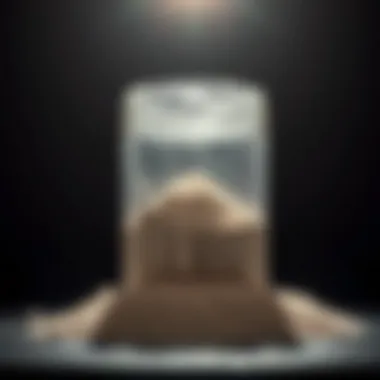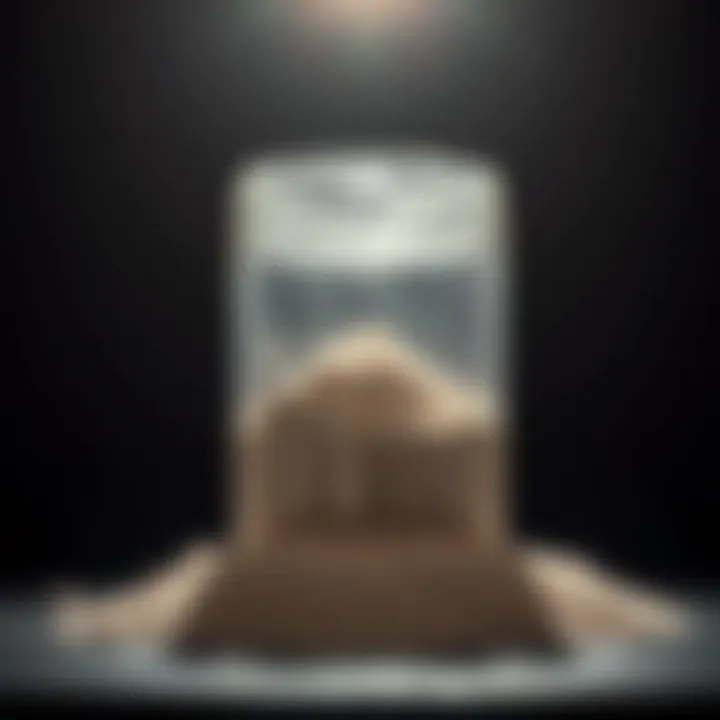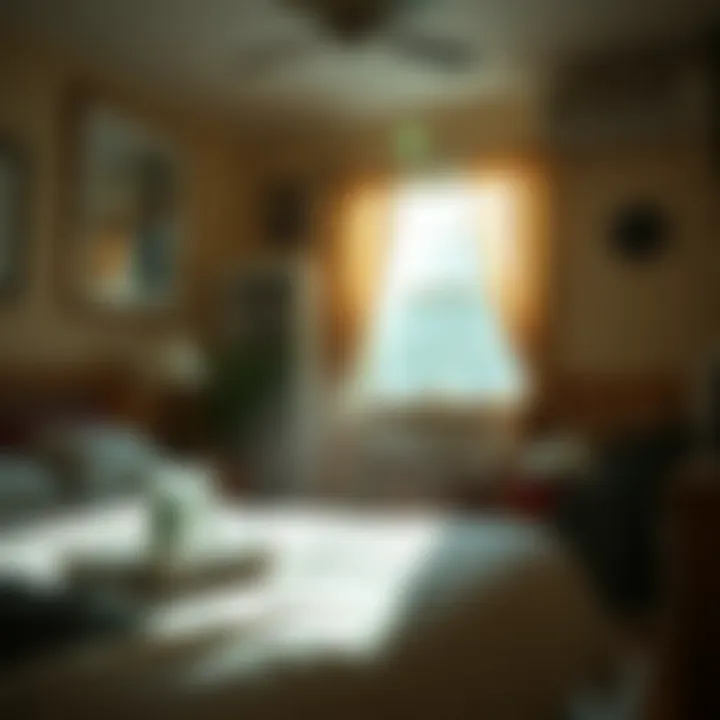Diatomaceous Earth: A Natural Approach to Bed Bug Control


Intro
Bed bugs, those tiny wingless creatures, have become a bane for many homeowners in recent years. As these nuisances stealthily invade homes, they can disrupt sleep and prove to be quite the headache to eradicate. Among various pest control methods, one natural alternative gaining attention is diatomaceous earth. This article will explore the properties of diatomaceous earth, how it works against bed bugs, and its advantages and safety in pest control.
Arming yourself with the right knowledge can make a significant difference in battling these pesky critters. By understanding the bed bug’s identification, prevention strategies, and effective treatment options, both seasoned pest control professionals and vigilant homeowners can wield diatomaceous earth as a potent weapon against infestations.
Pest Identification
Identifying bed bugs is crucial to manage them effectively. These small insects, typically brownish in color, have a flat, oval shape and can often be mistaken for other pests. Adult bed bugs can reach up to 5 mm in length, while nymphs are considerably smaller, about the size of a pinhead.
Detailed Descriptions of Common Pests
Bed bugs primarily feed on blood, making their presence known especially at night when they are active. They often hide in the seams of mattresses, within the cracks of bed frames, or behind headboards. Spotting adult bed bugs is unfortunately not the only indicator of an infestation.
Signs and Symptoms of Infestations
- Bites: Red, itchy welts on the skin are common signs of bed bug bites.
- Fecal Stains: Dark spots on bedding and surfaces can indicate bed bug droppings.
- Eggs and Molts: Tiny white eggs or shed skin may be present in areas where they hide.
If you observe any of these signs, it’s time to take action to prevent further spreading. Understanding the habits and lifecycle of bed bugs equips you with the ability to combat their presence more effectively.
Prevention Strategies
When it comes to bed bugs, an ounce of prevention is worth a pound of cure. Taking proactive measures can save homeowners from the stress of dealing with an infestation. Here are some practical tips:
Home Maintenance Tips for Pest Prevention
- Thorough Cleaning: Regular vacuuming of carpets and upholstery can help catch bed bugs before they take hold.
- Seal Cracks and Crevices: Inspecting and sealing possible entry points helps limit bed bugs from finding a way into your home.
- Careful Secondhand Purchases: Always inspect used items, especially mattresses and furniture, before bringing them into your home.
Natural Deterrents and Barriers
- Diatomaceous Earth: A natural powder that can be sprinkled in areas prone to bed bug activity. Its abrasive properties can harm the insect’s outer shell, ultimately leading to dehydration.
- Essential Oils: Some homeowners swear by mixing oils such as tea tree or lavender in sprays to deter bed bugs. While not a full-proof solution, they can complement other methods well.
Implementing these strategies can lessen the chances of bed bugs becoming a problem in your living space.
Treatment Options
When it comes to treatment, various methods exist in the realm of pest control. Understanding how diatomaceous earth compares with traditional chemical treatments is essential for homeowners looking for effective solutions.
Overview of Chemical vs. Natural Treatments
Chemical pesticides often hold a strong position in pest management but can come with a host of side effects or health risks. In contrast, natural options, like diatomaceous earth, present an alternative that doesn’t rely on harmful substances. The fundamental difference lies within their operational mechanisms: chemicals kill on contact while diatomaceous earth works through desiccation.
Step-by-Step Guides for DIY Treatments
- Identify Infested Areas: Before applying treatments, pinpoint areas where bed bugs are most prevalent.
- Apply Diatomaceous Earth: Use a dust applicator to lightly dust areas—around bed frames, mattress seams, and even under furniture. Make sure to wear a mask to avoid inhaling the powder.
- Leave it Be: Allow the diatomaceous earth to sit for a few days. This gives it enough time to work on bed bugs that may come into contact with it.
- Clean Up: After a few days, vacuum the areas treated to remove dead bugs and excess powder.
Using diatomaceous earth as part of your treatment plan provides not just an effective, but also a safer option for controlling bed bugs.
For more extensive information and resources on pest management strategies, you may refer to CDC and PestWorld.
Understanding Bed Bugs
Understanding bed bugs is essential for anyone looking to tackle these unwelcome pests effectively. Bed bugs, scientifically known as Cimex lectularius, can turn a comfortable home into a source of anxiety and discomfort. They thrive in various environments, making their management a critical discussion point in pest control. Gaining insight into bed bug biology, their behavioral patterns, and the signs of infestation not only arms you with knowledge but also boosts your confidence in combating these nuisances.
Biology of Bed Bugs
Bed bugs are small, flat, and oval-shaped insects that typically measure about 5-7 millimeters in length. Their bodies are brownish in color, which can make them hard to spot against various surfaces. One significant aspect of their biology is their lifecycle, which includes five nymph stages before reaching adulthood, with each stage requiring a blood meal to advance. They can survive for several months without feeding, allowing their populations to flourish even in sparse conditions.
Here's a brief overview of their lifecycle:
- Eggs: Tiny, white, and hard to see; they hatch in about 6 to 10 days.
- Nymphs: Young bed bugs that feed on blood, developing through stages before maturity.
- Adults: Capable of reproducing quickly, with females laying several eggs daily.
With their exceptional resilience and rapid reproductive capability, understanding their biology helps in formulating an effective pest management strategy. By knowing how quickly they multiply and survive, homeowners can take swift measures to mitigate an infestation.
Behavioral Patterns


Bed bugs are primarily nocturnal, meaning they prefer to come out under the cover of darkness to feed. They use heat and carbon dioxide as signals to locate their hosts. This behavior often leads people to wake up with multiple bites, usually not realizing they are being fed upon until the morning.
They tend to hide in tight spaces, which may include:
- Mattresses and box springs
- Behind electrical outlets
- In cracks and crevices of wooden furniture
Identifying these hiding spots is crucial for effective control, and understanding their behavior can guide treatment efforts. Implementing preventive measures like regular inspections of sleeping areas and being cautious when traveling can disrupt their habits before they escalate into a full-blown infestation.
Signs of Infestation
Recognizing the signs of a bed bug infestation early can save homeowners from extensive damage and stress. Symptoms to look out for include:
- Bites: Often appear as red, itchy welts. The bites usually occur in a straight line or cluster.
- Fecal stains: Dark spots on sheets or mattresses can indicate the presence of bed bugs.
- Shed skins: Nymphs molt and shed their skin, which can be found in the infested areas.
- Eggs and egg shells: These can be tiny and often found in hidden areas.
"The sooner you check and identify these signs, the faster you can take action to regain your space from bed bugs."
In summary, understanding bed bugs encompasses their biology, behavior, and signs of infestation. This knowledge serves as the foundation for effective pest control strategies, reducing anxiety and protecting one's home from the relentless clutches of these pests. By arming yourself with information, you bolster your chances of managing and ultimately eliminating bed bug problems.
Intro to Diatomaceous Earth
Diatomaceous earth, often abbreviated as DE, has gained significant attention in recent years as a natural solution for pest control, particularly when it comes to the persistent issue of bed bugs. Understanding this material is essential for homeowners and pest control professionals seeking effective, alternative methods to combat these stubborn nuisances. This section outlines what diatomaceous earth is, its diverse sources and types, as well as its safety profile when used in pest management.
What is Diatomaceous Earth?
Diatomaceous earth is a naturally occurring, soft sedimentary rock that is crumbled into a fine white to off-white powder. Its composition is predominantly made of the fossilized remains of diatoms, which are tiny aquatic organisms. The unique way diatomaceous earth works lies in its physical properties rather than chemical reactions. When bed bugs and other insects come into contact with diatomaceous earth, the tiny, sharp particles damage their exoskeletons, leading to dehydration and eventual death. This mechanism of action makes DE a purely physical control method—lacking any synthetic chemicals, it appeals to those conscious of the environment.
Sources and Types
Diatomaceous earth is sourced from various environments around the world, with major deposits found in the United States, Germany, and France. These deposits are categorized into two main types: food grade and filter grade.
- Food Grade Diatomaceous Earth: This particular type of DE is safe for humans and pets and is often used in various applications, including as a natural insecticide, a dietary supplement, and in food preservation. Its rounded particles make it less abrasive, making it suitable for consumption.
- Filter Grade Diatomaceous Earth: Primarily intended for industrial use, this type of DE is more abrasive and is often used in swimming pool filtration systems. It is not safe for human consumption, and its application is generally limited to non-food-related uses.
When considering DE for bed bug control, only food grade diatomaceous earth should be used to avoid health risks associated with filter grade varieties.
Safety and Environmental Impact
One of the significant advantages of diatomaceous earth is its safety profile. Food grade DE is recognized by the Environmental Protection Agency as safe for use in homes and gardens. Its non-toxic nature is vital for households with children and pets, making it a favorable option compared to traditional chemical pesticides.
However, while diatomaceous earth presents minimal risk to humans and animals in its food grade form, it’s essential to use it responsibly. Avoid inhaling the dust, as it can irritate the respiratory system if introduced into the lungs. Furthermore, diatomaceous earth does not discriminate; it is effective against beneficial insects along with pests. Therefore, care should be taken to apply it only in targeted areas to prevent collateral damage to helpful insects.
In summary, the introduction of diatomaceous earth as a natural pest control solution offers a valuable alternative for those dealing with bed bugs, with its unique properties, diverse types, and safety considerations setting it apart from traditional methods. As we progress through this article, the focus will be on how to effectively use DE in practical situations and integrate it into broader pest management strategies.
Mechanism of Action
Understanding how diatomaceous earth functions provides a solid ground for those considering it as a method to combat bed bug infestations. Rather than merely relying on anecdotal evidence, grasping the mechanisms at play underpins its effectiveness as a natural solution.
Diatomaceous earth, a powdery substance made from the fossilized remains of tiny aquatic organisms called diatoms, works primarily through physical action. When bed bugs come into contact with it, the microscopically sharp particles damage their exoskeleton, leading to dehydration and eventual death. This property of desiccation, rather than a chemical reaction, is what makes diatomaceous earth distinct and appealing to those wary of chemical pesticides.
How Diatomaceous Earth Affects Bed Bugs
When bed bugs wander into areas treated with diatomaceous earth, the powder clings to their bodies. The abrasive nature of this substance creates minute cuts on the bugs' exoskeleton. It disrupts their ability to retain moisture, ultimately leading to desiccation which, in pest control terms, equates to death.
- Application Method Matters: For maximum efficacy, it’s essential that diatomaceous earth is applied in a manner that ensures bed bugs come into contact with it. Thin, even layers spread across the perimeters of the infested areas are particularly effective.
- No Chemical Residue: A key benefit of using diatomaceous earth is its lack of chemical residues. Homeowners can use it in areas where children and pets roam, minimizing health risks often associated with traditional pesticides. This makes it an attractive option for families looking to keep their environment safe.
"The sheer mechanical action of diatomaceous earth represents a clean and effective strategy to deal with bed bugs while avoiding the pitfalls of harsh chemicals."
Physical vs. Chemical Control Methods
When comparing diatomaceous earth with chemical control methods, several factors come into play, impacting effectiveness, safety, and environmental considerations.
- Efficacy of Action:
- Speed of Results:
- Safety and Environmental Impact:
- Resistance Issues:
- Diatomaceous Earth: Relies on physical action, working only through contact with the pest.
- Chemical Pesticides: Often require a specific dose and may need to be reapplied multiple times for efficacy, as many bugs can develop resistance over time.
- Diatomaceous Earth: Results can be slower, as bed bugs must contact the powder and die over time from dehydration.
- Chemical Pesticides: Tend to work quickly, killing bugs on contact but may lead to immediate reinfestation.


- Diatomaceous Earth: Typically safe for humans and pets when used correctly; it’s less likely to pollute the living environment. Often favored in organic pest control approaches.
- Chemical Pesticides: Frequently come with health warnings and may pose risks to both humans and the environment. Long-term exposure can lead to unforeseen health complications.
- Diatomaceous Earth: Since it acts in a physical manner, bed bugs do not build resistance against it.
- Chemical Pesticides: Many strains of bed bugs exhibit resistance due to overuse of specific chemicals, complicating eradication efforts further.
Ultimately, while both methods have their merits, diatomaceous earth offers a unique, sustainable approach to bed bug control that aligns well with the increasing demand for eco-friendly pest management solutions. Understanding these distinctions is vital for homeowners, allowing for informed decisions when facing bed bug challenges.
Application Techniques
When dealing with bed bugs, having a solid grasp of application techniques can be the linchpin in tackling these pests effectively. The right methods can make all the difference between successful eradication and ongoing infestation. Using diatomaceous earth comes with unique considerations and best practices that homeowners should familiarize themselves with. Understanding these techniques not only maximizes efficacy but also ensures a safer environment for families and pets alike.
Preparation for Application
Before launching into the application of diatomaceous earth, some careful groundwork is essential. Here's how to prep like a pro:
- Identify Infested Areas: Start by pinpointing the hotspots. Check bed frames, seams of mattresses, carpets, and any nooks and crannies that could be harboring bed bugs.
- Clean Your Space: Vacuuming is your first line of defense. A thorough vacuuming will remove not just the bugs but also the eggs and fecal matter, making it easier for diatomaceous earth to work its magic.
- Wear Protective Gear: Though diatomaceous earth is relatively safe, it’s wise to don a mask and gloves during application. This simple step can help avoid unnecessary inhalation and skin irritation.
- Choose the Right Product: Not all diatomaceous earth is created equal. Make sure you’re using food-grade DE rather than the kind meant for swimming pools or construction sites.
By doing all these tasks beforehand, you prepare a clean slate to optimize the effectiveness of the diatomaceous earth treatment.
Best Practices for Effective Use
To ensure you are using diatomaceous earth to its fullest potential, consider the following best practices:
- Even Distribution: Use a duster for even application. Sprinkling it in clumps won’t do you any favors; bed bugs are clever and can sidestep heavy piles.
- Focus on Cracks and Crevices: Bed bugs love to hide in small spaces. Concentrate your application in places like baseboards, behind headboards, and in any other small crevices.
- Apply in Layers: A thin layer is usually much more effective than a thick pile. You aren’t creating a sandcastle here. Light dusting will allow the bed bugs to come in contact without being pushed away from the treatment area.
- Leave It Be: Once applied, resist the urge to vacuum or clean right away. The diatomaceous earth needs time to do its job, often requiring a few days to a week before your second treatment.
By adhering to these practices, the chances of successfully eliminating bed bugs skyrocket.
Post-Application Recommendations
After applying diatomaceous earth, it’s crucial to follow up correctly:
- Let it Work: Patience is key. Give the diatomaceous earth sufficient time to work through the bed bug population. Refrain from vacuuming or wiping down areas immediately.
- Monitor Progress: Keep an eye out for signs of bed bugs after application—this may include spotting dead bugs or even noticing less activity. If you notice a resurgence, you may need to reapply.
- Routine Checks: Conduct ongoing inspections. Regularly check your sleeping areas and other spots where you initially found bugs to ensure they haven't returned.
- Combine with Other Methods: Sometimes, it takes a village. Consider integrating diatomaceous earth with other pest management strategies for a more holistic approach.
In summary, applying diatomaceous earth requires a thoughtful and methodical approach. From getting ready to the application and post-application, each step is vital to ensuring a pest-free home. And remember, every household is different, so be willing to tweak your approach based on what you observe.
Challenges and Limitations
Understanding the drawbacks and limitations related to the use of diatomaceous earth in controlling bed bugs is crucial for anyone considering it as a pest management solution. While it presents a natural alternative, being aware of its potential shortcomings can help homeowners set realistic expectations. This section aims to unpack some of the challenges faced when utilizing diatomaceous earth, offering a more nuanced view of this method.
Effectiveness Under Varying Conditions
Diatomaceous earth, though effective, doesn't operate in a vacuum. Its performance heavily depends on environmental conditions and how precisely it is applied. For instance, humidity plays a significant role; if the air is damp, the powder can become less effective. This is because the moist environment can cause the diatomaceous earth to clump together, reducing its abrasive properties, which bed bugs cannot withstand when it’s dry.
• High Humidity: When the moisture level is elevated, the effectiveness of diatomaceous earth can drop significantly. Users might find it ineffectual against infestations during humid weather.
• Placement: It’s essential to apply the powder in the right areas—cracks, crevices, and other hiding places. If it’s scattered on open surfaces, bed bugs might avoid direct contact with it. Successful implementation means knowing the lay of your home.
"Diatomaceous earth's effectiveness is like a good recipe; if ingredients aren’t mixed right, you’re bound to end up with a dish that falls flat."
Resistance and Behavioral Adaptations in Bed Bugs
A significant concern with pest management is the development of resistance. Bed bugs are notoriously tough, and as a result of continuous exposure to various control methods, these pests can adapt in ways that may render solutions ineffective over time. While diatomaceous earth acts mechanically rather than chemically, there's always a chance that bed bugs may find ways to compromise its efficiency.
• Behavioral Adjustments: Over time, bed bugs may alter their behavior to evade diatomaceous earth. For instance, they might change their hiding spots or feeding patterns, making it harder for this solution to make contact with them.
• Re-infestation Risks: If a home previously endured a bed bug problem and used diatomaceous earth, reintroducing this powder without proper sanitation and monitoring could result in bed bugs effectively avoiding the treatment areas.
In summary, while diatomaceous earth can be a formidable player in the game against bed bugs, understanding its limitations and challenges is just as vital to your pest control strategy as knowing its strengths. Homeowners should adopt a comprehensive approach that includes proper monitoring and possibly integrating other pest control methods, ensuring a well-rounded offensive against these unwelcome guests.
Comparative Analysis
Comparing diatomaceous earth to other pest control strategies is crucial in understanding its role and effectiveness against bed bugs. This section dives into the nuts and bolts of how diatomaceous earth measures up against chemical pesticides, as well as its integration into broader pest management systems. Knowing the strengths and weaknesses of diatomaceous earth provides homeowners with the ability to make informed decisions in their fight against these persistent pests.
Diatomaceous Earth vs. Chemical Pesticides
When homeowners consider pest control methods, they often find themselves at a crossroads: should they opt for traditional chemical pesticides or pursue a more natural route like diatomaceous earth?
Diatomaceous earth offers a distinct set of qualities that differ significantly from chemical alternatives:


- Mode of Action: Unlike chemical pesticides which often focus on disrupting a pest’s nervous system, diatomaceous earth acts as a desiccant. This means it works by dehydrating bed bugs as they walk through the fine powder. They lose moisture and eventually die, making it less likely that they will develop resistance, a common issue with chemical methods.
- Safety: Many chemical pesticides come with a laundry list of warnings regarding usage around pets and children. In contrast, food-grade diatomaceous earth is relatively safe around non-target organisms.
- Environmental Impact: Chemical pesticides can leave behind residues that harm the environment and contribute to the disruption of local ecosystems. Diatomaceous earth, as a natural product, is generally higher on the safety scale in this regard. However, it must be noted that while it’s safer, it’s still important to use it responsibly and in the appropriate manner.
- Efficacy Duration: Chemical treatments tend to have a longer residual effect, offering continued protection even after the initial application. On the flip side, diatomaceous earth may require reapplication, especially in high-traffic areas or where there is moisture present. This can be a consideration for those managing severe infestations or expecting recurrent issues.
In summary, while chemical pesticides provide rapid results and lingering effects, diatomaceous earth offers a natural, safer alternative that can be very effective, especially when used properly.
Diatomaceous Earth in Integrated Pest Management
In the realm of pest control, the term Integrated Pest Management (IPM) often crops up as a holistic and sustainable approach. This philosophy combines multiple strategies to manage pests effectively, minimizing harm to humans, non-target organisms, and the environment.
Diatomaceous earth is a versatile tool within this framework. Here’s how it fits in:
- Complementary Control: While diatomaceous earth can certainly be used alone, it shines when paired with other methods like vacuuming, heat treatment, and even natural repellents. This multi-faceted strategy helps to minimize dependencies on any single method, including chemical pesticides.
- Monitoring and Prevention: Applying diatomaceous earth in likely hiding spots serves not only as a treatment but also as a preventive measure. It can help to disrupt the life cycle of bed bugs before they become an infestation.
- Training and Education: For homeowners determined to tackle infestations, understanding how to properly use diatomaceous earth is essential. An educated approach improves its effectiveness and reduces the chances of misapplication.
Utilizing diatomaceous earth within an IPM strategy underscores its adaptability. By respecting the environment and synergizing with various control methods, homeowners can turn the tide against bed bugs more effectively.
"Natural methods like diatomaceous earth could be the key to breaking the reliance on chemical pesticides, fostering a healthier living space while tackling the persistent problem of bed bugs."
Case Studies and Research Findings
Understanding the effectiveness of diatomaceous earth in combating bed bugs requires more than just theory; it necessitates practical insights gained from real experiences and detailed scientific research. Case studies and research findings help illuminate how this natural solution performs in different scenarios, providing a clear picture of its effectiveness—especially when used as part of a broader pest management strategy. Examining specific examples also lends credibility to the claims and shows the practical benefits and considerations that homeowners should ponder before diving into application.
Success Stories with Diatomaceous Earth
There are countless accounts from individuals who turned to diatomaceous earth as their go-to method for dealing with annoying bed bug infestations. These success stories often begin with despair, as many homeowners find themselves at their wit’s end, trying various chemical solutions without much satisfaction. For instance, a family from Ohio shared that after struggling with a particularly stubborn infestation, they adopted diatomaceous earth and saw remarkable changes within just a few weeks. They noted that the level of bed bug activity diminished significantly after they applied the powder in their bedroom and near furniture seams.
"It felt like a miracle. We were ready to toss the mattresses, but diatomaceous earth turned out to be the saving grace."
Not only that, but they highlighted the lack of unpleasant odors or chemical residues that often accompany conventional pesticides. Customers simply appreciated the peace of mind knowing they had opted for a product that was safer for both kids and pets while still effectively addressing their infestation.
Scientific Studies on Efficacy
The anecdotal successes are further bolstered by scientific research. Numerous studies have shown that diatomaceous earth can contribute effectively to bed bug control. An experiment conducted by researchers at Purdue University revealed that bed bugs exposed to a treatment of diatomaceous earth suffered significant mortality within a week. This study further investigated different types of diatomaceous earth and concluded that those high in amorphous silica were notably more effective against bed bugs.
Another noteworthy study published in the Journal of Economic Entomology provided insights into how diatomaceous earth operates. Researchers noted that the fine particles abrade the waxy exoskeleton of bed bugs, causing dehydration and ultimately leading to their demise. Such findings offer a scientific basis for the numerous success stories floating around, demonstrating that the method is not merely anecdotal but grounded in rigorous analysis.
In summary, both user testimonials and scientific findings contribute to a solid understanding of diatomaceous earth's role in bed bug elimination. Not only do personal accounts provide insight into practical applications, but research studies validate their effectiveness, reinforcing diatomaceous earth's standing as a significant natural solution in pest control frameworks.
User Testimonials and Experiences
User testimonials and experiences hold significant weight when discussing the effectiveness of diatomaceous earth (DE) in controlling bed bugs. These narratives not only provide proof of the product's efficacy but also offer insights into real-world applications and the challenges that come with them. When homeowners and pest control professionals share their stories, they elevate the discussion beyond theoretical benefits, adding a personal touch that makes the information relatable and credible.
Through these accounts, users can highlight specific elements such as ease of application, observable results, and long-term effectiveness. Furthermore, testimonials can cover considerations that potential users need to weigh, like encountering resistant bed bug populations or the importance of thorough application.
Homeowners' Perspectives
Homeowners who have chosen diatomaceous earth for bed bug control often report a range of experiences from effective results to learned lessons. For many, the proactive stance of using a natural option can provide peace of mind that aligns well with their lifestyle choices.
Common themes in homeowner testimonials include:
- Initial Hesitation: Many users are initially skeptical about whether DE would be as effective as chemical pesticides. However, after applying it according to guidelines, they notice a drop in bed bug sightings within weeks.
- Ease of Use: Several homeowners concur that spreading diatomaceous earth in affected areas, such as mattress seams, crevices, and baseboards, is less complex than anticipated.
- Caution with Residue: Some testimonials mention the fine, powdery texture of DE, which can create a mess if not handled properly. Users recommend applying it with a shaker to minimize the scatter.
- Visible Results: A common narrative is the spotting of dead bed bugs within a short time frame after application, which reassures homeowners that they are on the right track.
"I was hesitant at first, but seeing those little critters gone made me a believer! It's not magic, but it works. Just remember, it takes a little time and care to apply."
Pest Control Professionals' Insights
Pest control experts bring a different perspective to the effectiveness of diatomaceous earth. Their experiences are often more technical and rooted in a broader understanding of pest control measures.
Insights commonly shared by professionals include:
- Complementing Strategies: Many professionals emphasize that while diatomaceous earth can be an effective tool, it is most potent when combined with other pest control methods.
- Understanding Limitations: Experts often note that DE can be less effective against very high infestations. For these conditions, an integrated approach that utilizes both DE and targeted insecticides might yield better results.
- Customer Education: Professionals highlight the importance of educating homeowners about proper application techniques to enhance effectiveness. They often share tips about maintaining a barrier, ensuring that the powder remains undisturbed for optimal efficacy.
- Ongoing Research: Interestingly, many pest controllers keep abreast of emerging studies on diatomaceous earth, helping them to refine their techniques and provide updated advice to clients.
Culmination and Recommendations
As we draw our discussion to a close, it becomes clear that the intricacies of bed bug control require a multifaceted approach. Diatomaceous earth emerges as a vital player in this narrative. Its unique physical properties allow it to serve as a natural solution, distinguishing it from the more hazardous chemical pesticides typically employed. By using diatomaceous earth, homeowners can effectively combat infestations while minimizing potential harm to their family and pets. This is particularly significant for those who value a green lifestyle and seek to avoid the synthetic chemicals found in many commercial products.
One of the key recommendations is to consider integrating diatomaceous earth within a broader pest management plan. While it has proven efficacy, using it in collaboration with other methods, such as vacuuming or sealing entry points, can amplify its effectiveness. It's important to realize that diatomaceous earth might not work like a magic bullet; rather, it needs to be part of a systematic approach to succeed.
Additionally, consistent monitoring for signs of renewed activity can help ensure that any future infestations are managed quickly. Homeowners should be prepared for a bit of trial and error, as the specific conditions of each home may influence the overall results. As they often say, what works for one may not work for all.
"Success in bed bug control boils down to a combination of strategies—don’t put all your eggs in one basket."
In terms of considerations, it’s wise to heed safety precautions when applying diatomaceous earth. It’s generally safe, but inhaling excessive amounts of dust can cause irritation. Therefore, using a mask during application is advisable. Furthermore, always ensure that the diatomaceous earth being used is food-grade, especially if it will be applied in living areas.
Lastly, the discussions surrounding future exploration of diatomaceous earth in pest control could yield some exciting advancements. As research continues, deeper insights into how this substance interacts with other potential pest management techniques may reshape its applications, making it even more effective for everyday use. Overall, the integration of diatomaceous earth into your pest strategies not only aligns with eco-conscious living but also empowers homeowners to tackle bed bugs more effectively.



